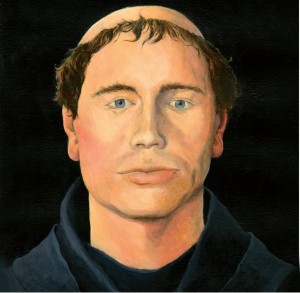Lihou island off of Guernsey’s west coast, at first, looks like a tranquil, if not rugged, haven of peace and security. But there is a darker more salacious history to it that would even make readers of today’s gossip mags gasp. In this article we look at foul murders and dark deeds in what was supposed to be a place of spiritual contemplation and service for God.
Origins…
The Benedictine Priory on Lihou Island was founded in the 12th century. It was a dative priory, which means that it was a place where dues were collected for the mother house, in this case Mont Saint Michel in Normandy. Robert de Torigni, Abbot of Mont Saint Michel, came to Guernsey in AD 1156, and his visit may have been for the dedication of the church.
The church was highly decorated with carved limestone from the Caen region of northern France, painted window glass and a floor of green and yellow glazed tiles. So although being situated in a rather rugged environment it wasn’t too bad a place to live.
Murder…
In 1304 Thomas Le Rover, a servant of the prior, killed one of the Lihou monks, Brother John de l’Espin, in the priory. When the body was discovered, the prior sent for the Bailiff, Ralph de Havilland, who came to Lihou with an armed party of men to arrest him.
 Le Rover was quickly cornered and caught. In the small force of men which de Havilland brought with him was a former bailiff named Ranulph de Gautier.
Le Rover was quickly cornered and caught. In the small force of men which de Havilland brought with him was a former bailiff named Ranulph de Gautier.
When they tried to arrest Le Rover, fighting broke out and Le Rover, trying to defend himself, was killed by Gautier. Gautier panicked and fled Lihou to the church of St Sampson where he claimed sanctuary.
The prior, Brother Calfridus, and the remaining monks also panicked, took to their boats and sailed with all speed to their mother church at Mont-St-Michel, leaving the two corpses sprawled in the priory precincts.
Discovery…
The next day two local men, Richard Paysent and Johanna Le Veylette, went to Lihou and discovered it to be deserted, food lying half-eaten, tasks left half-done and two unburied corpses lying just as they had been left.

Lihou tried to return to some sort of normality but this was only the beginning of this gruesome story
Thoroughly scared, they hurried home and said nothing. However, when Brother Calfridus finally returned, their visit was somehow discovered and they were fined for not having reported what they had found.
The grim task of clearing up began and the bodies of Brother John and Le Rover were finally removed and given a proper Christian burial. Lihou tried to return to some sort of normality but this was only the beginning of this gruesome story.
Retribution…
De Gautier, still hiding in sanctuary, eventually escaped from Guernsey and went to England, where he managed to obtain a letter of pardon from the king. He returned to his lands in the parish of the Vale, but, not being a popular man, a few days later he was imprisoned in Castle Cornet. One of the charges laid against him was his part in the death of Le Rover.
While in the castle, de Gautier was ‘put to death by many divers tortures …’ at the hands of three men: Gautier de la Salle, William l’Ingenieur and the ironically-named John Justice. The two last-named were pardoned for this crime but de la Salle was tried by the bailiff, Peter Le Marchant, and hanged in 1320. Thus the Lihou murder had claimed a total of four lives.
The motive for the murder of Brother John has never been established. Perhaps he caught Le Rover pilfering from the priory or poaching rabbits. Maybe they had a row that got out of hand we will never know.






You must be logged in to post a comment.